Bitcoin
Why The Bitcoin Bounce Off $66,000 Is Not Entirely Bad News

The Bitcoin price action in the past two weeks has reiterated its volatile nature despite the steady flow of institutional money. The cryptocurrency surged in the last days of September from $53,500 to a high of $66,000, only to pull back to $61,000 in the first few days of October, showing its unpredictable nature.
Interestingly, Bitcoin’s rally to reaching $66,000 has led to a change in the investing dynamics among holder cohorts. Furthermore, this change in dynamics reveals that its reversal and retest after the rally is not entirely bad news for Bitcoin’s price. In fact, this shift suggests that the pullback could be setting the stage for a more resilient long-term price outlook for Bitcoin.
Bitcoin’s Rejection At $66,000
Bitcoin’s recent break above $66,000 last week led to the creation of the first higher high since June. This notable Bitcoin development was noted by on-chain analytics platform Glassnode in a recent report. Bitcoin, which had initially created a higher low of $53,000 in September, eventually went on to break above the August high of $64,500. According to the report, the creation of this higher high led to a change in the profitability of short-term and long-term holder cohorts, with many more bitcoins moving into the long-term threshold.

Particularly, the recent rally has seen many coins acquired in close proximity to the $73,780 all-time high now being held for over 155 days. This, in turn, has seen many of these coins, which are in losses, now moving to long-term holder status. Although only 6.54% of long-term holders are in losses, they account for 47.4% of all coins in losses. While this might not bode well at the moment for these long-term holders, Glassnode notes that this is actually common during re-accumulation phases, as seen in the 2013, 2019 and 2021 periods. History shows that these have often led to price rallies.
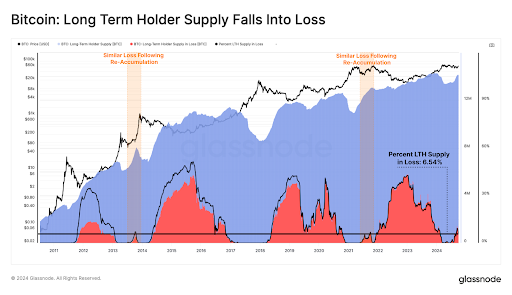
On the other end, profitability has improved massively among short-term holders. Glassnode data shows that a significant number of coins that are still in the short-term cohort have a cost basis between $53,000 and $66,000. Interestingly, the last rally has pushed the profitability of short-term holder supply to over 62%. Notably, profit-taking volumes are now 14.17 times larger than for loss-taking. As such, the financial pressure on short-term holders has now been eased, and many of them now have incentives to keep holding.
What Next For Bitcoin?
Despite Bitcoin’s recent reversal at $66,000, the cryptocurrency finds itself in a stronger and more profitable position for investors around the board compared to where it stood just a month ago. Furthermore, the rejection at $66,000 has given investors, especially long-term holders, another chance to load up on their holdings.
At the time of writing, Bitcoin is trading at $61,200.
Featured image created with Dall.E, chart from Tradingview.com
Bitcoin
5 US Economic Events With Crypto Market Implications This Week

Five key US economic indicators could influence Bitcoin (BTC) sentiment this week amid heightened bearish sentiment in the crypto market.
The influence of US economic events and policies on Bitcoin and crypto in general continues to grow. This makes the anticipated data points particularly important for traders and investors.
US Economic Data To Watch This Week
Amid the crypto black Monday woes, this week’s US economic data will be crucial for Bitcoin and altcoin markets.
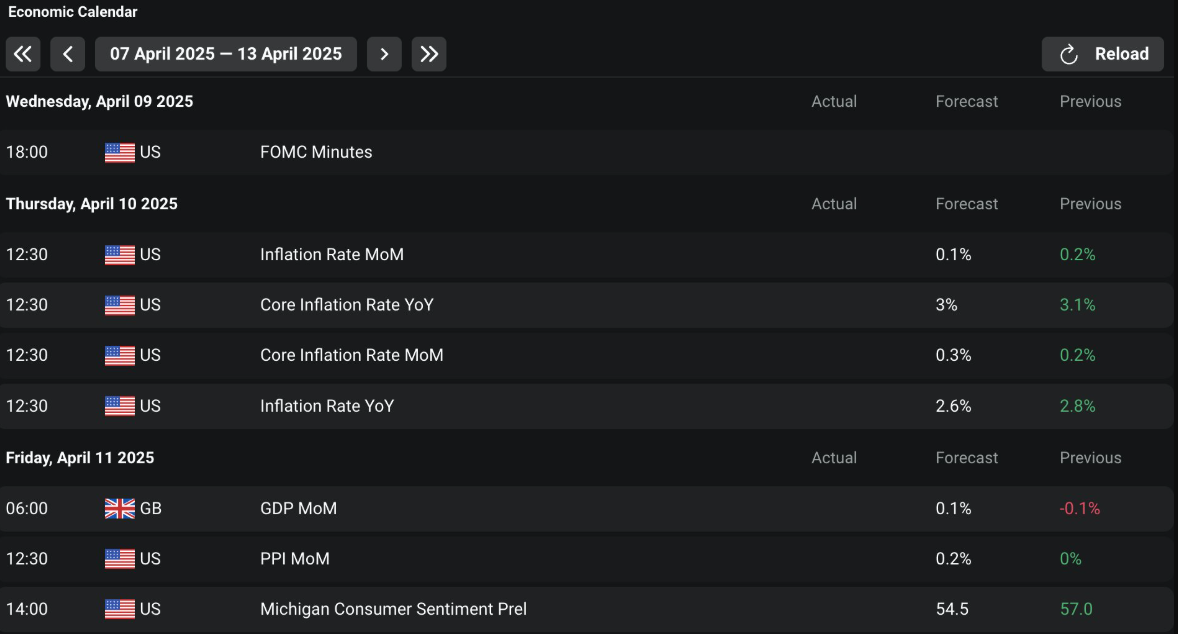
March FOMC Minutes
The Federal Open Market Committee (FOMC) minutes from the March meeting are due on Wednesday. This US economic indicator will offer traders and investors a window into the Federal Reserve’s (Fed) monetary policy direction.
These minutes detail discussions on interest rates, inflation, and economic growth, influencing market sentiment. If the tone is hawkish, suggesting tighter policy or fewer rate cuts, Bitcoin could face downward pressure as investors favor safer assets like bonds, bolstered by a stronger US dollar.
Conversely, a dovish outlook hinting at rate cuts could boost risk appetite, driving capital into crypto. This would come as cheaper borrowing encourages investment in high-growth assets.
Based on these, crypto traders will watch for clues about the Fed’s stance on inflation. This is more so considering recent data showed no significant re-acceleration.
Fed Chair Jerome Powell could reaffirm previous comments about resisting premature rate cuts, or new signals might emerge. Given Bitcoin’s sensitivity to liquidity, any unexpected pivot could spark volatility.
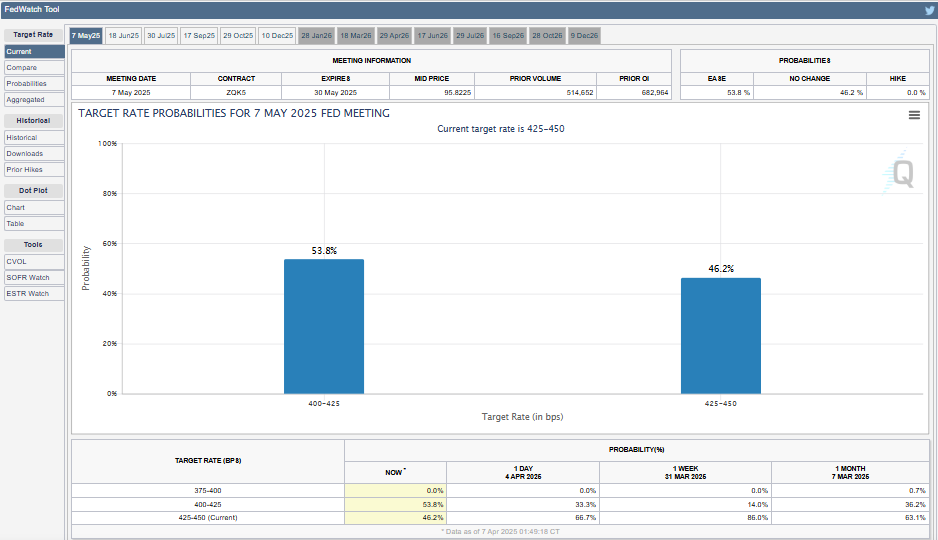
Traders and investors should brace for short-term price swings, particularly if the minutes deviate from market expectations priced in by the CME FedWatch.
JPMorgan is the first Wall Street bank to forecast a US recession following Trump’s tariffs. According to the bank, the FED might be forced to cut rates before the next meeting. Notably, the next FOMC meeting after the April 9 minutes will be May 6-7, 2025.
Despite JPMorgan’s fears and urges, the ongoing crypto market bloodbath notwithstanding, no emergency meetings are announced for April as per the Fed’s official calendar. Accordingly, the next likely date for any policy changes, like the rate cut JPMorgan mentioned, is May 6-7.
“The next FOMC meeting is on the first week of May, can investors wait? Can US people wait? How high is current inflation? Can we have an urgent rate cut meeting? Until China enters crypto, BTC still depends on US liquidity,” one user noted.
Initial Jobless Claims
Beyond the March FOMC minutes, the next US economic indicator for crypto traders to watch is the Initial Jobless Claims. Due every Thursday, this report provides crypto market participants with a real-time snapshot of US labor market health. This makes it a key driver of economic stability.
Measuring new unemployment filings, lower claims would signal a strong economy, while higher claims indicate weakness.
For crypto, a strong labor market (fewer claims) might dampen Bitcoin’s appeal as investors lean toward traditional equities. However, rising claims could fuel recession fears, prompting the Fed to consider rate cuts. Historically, this has been a boon for crypto, as lower rates make borrowing cheaper and increase liquidity.
Traders will, therefore, monitor whether claims exceed the previous week’s 219,000. Such an outcome would boost Bitcoin as a hedge against economic uncertainty.
Meanwhile, recent trends show claims have been declining. However, rising continuing claims suggest that job-finding challenges persist.
Crypto volatility could spike if the data surprises, especially alongside Thursday’s interplay, with the CPI release coming shortly afterward.
“US Core Inflation Rate and CPI (Thu10) and Initial Jobless Claims (Thu10) are top-tier market movers, likely impacting USD, bond yields, and Fed rate expectations amid tariff uncertainties,” one user noted.
US CPI
The Consumer Price Index (CPI), which will be released on Thursday, is another critical US economic indicator for crypto market participants to watch. The data measures inflation through changes in consumer goods and services prices.
A higher-than-expected CPI could signal persistent inflation, potentially leading the Fed to maintain or raise rates. This would strengthen the dollar and pressure crypto prices downward as risk assets lose appeal.
The previous CPI data showed inflation cooled to 2.8% in February. If March’s CPI exceeds the anticipated 2.6% annual rise, Bitcoin might dip as investors pivot to inflation-resistant assets.
Conversely, a lower CPI could reinforce expectations of rate cuts, boosting crypto as a store of value amid easing monetary policy.
Crypto traders will also focus on core CPI (excluding food and energy) for a clearer inflation trend, as it heavily influences Fed decisions.
Given Bitcoin’s April performance dropping below $75,000, this data could dictate its next move. Volatility is almost certain, so participants must be ready for market reactions, especially as FOMC minutes will still be fresh in mind.
US PPI
Friday’s Producer Price Index (PPI) tracks inflation at the wholesale level. This US economic indicator offers crypto market participants insight into production costs that could trickle down to consumers.
Rising PPI suggests higher input costs, like energy or hardware, which are crucial for crypto mining. This could squeeze miner profitability and reduce Bitcoin supply growth.
If March’s PPI climbs significantly above 3.3% year-over-year, it might signal brewing inflationary pressure. This could prompt a Fed tightening bias that could weigh crypto prices as liquidity tightens.
Conversely, a softer PPI might ease inflation fears, supporting a bullish crypto outlook if paired with dovish Fed signals on Wednesday.
Crypto investors should note PPI’s lead indicator status for CPI. A stark divergence from Thursday’s CPI could confuse markets and heighten volatility.
“Massive macro week ahead FOMC minutes, CPI, and PPI. A battleground for rate cut bets,” Deribit noted.
With Bitcoin sensitive to dollar strength, participants should watch how PPI shapes Fed expectations. A balanced reading might stabilize sentiment, but surprises could trigger sharp moves.
Consumer Sentiment
The University of Michigan’s Consumer Sentiment Index, released Friday, will reflect US consumers’ economic confidence. This is a vital signal for crypto market participants.
A high reading indicates optimism, potentially spurring spending and risk-taking, which could lift Bitcoin as investors seek growth assets. Strong sentiment might also reduce recession fears, indirectly supporting crypto by maintaining market liquidity.
However, a drop below expectations of 54.5 could hint at inflation or job worries, denting risk appetite. This could push funds toward safer havens, pressuring crypto prices. This index often embeds inflation expectations, such that Bitcoin’s hedge narrative could strengthen if consumers anticipate rising prices.
These events collectively shape the crypto market sentiment this week, intertwining monetary policy, economic health, and investor psychology.
Participants must stay agile and blend data insights with market reactions to develop informed strategies. They must also conduct their own research.
Disclaimer
In adherence to the Trust Project guidelines, BeInCrypto is committed to unbiased, transparent reporting. This news article aims to provide accurate, timely information. However, readers are advised to verify facts independently and consult with a professional before making any decisions based on this content. Please note that our Terms and Conditions, Privacy Policy, and Disclaimers have been updated.
Bitcoin
Will 2025’s Crypto Market Mirror 2020’s Rebound? Analysts Predict

Over the weekend, the cryptocurrency market took a sharp dive, with major assets suffering significant losses. While the downturn has raised concerns, some crypto experts believe it could present an opportunity for potential future gains.
This outlook comes amid widespread fears about a potential global recession and escalating trade wars.
Will the Market Crash Lead to a New Class of Crypto Millionaires? Experts Weigh In
BeInCrypto reported a dramatic plunge in the cryptocurrency market today. The total market capitalization dropped by $216 billion within the past 24 hours. Bitcoin (BTC) also saw a significant decline, falling below the $75,000 mark.
Amidst this, an analyst highlighted that the US Economic Policy Uncertainty Index has reached an unprecedented high. For context, this index measures the level of uncertainty in the US economy related to policy changes.
It combines newspaper mentions of economic uncertainty with data on tax policy and budget deficits. A higher index value indicates greater uncertainty, which can influence market volatility, investor behavior, and economic decision-making.
Notably, it has surpassed levels seen during the 2008 financial crisis and the 2020 COVID-19 market crash.
“The market has never been more uncertain than it is right now. It’s worse than both the great financial crisis & the covid crash,” he posted.
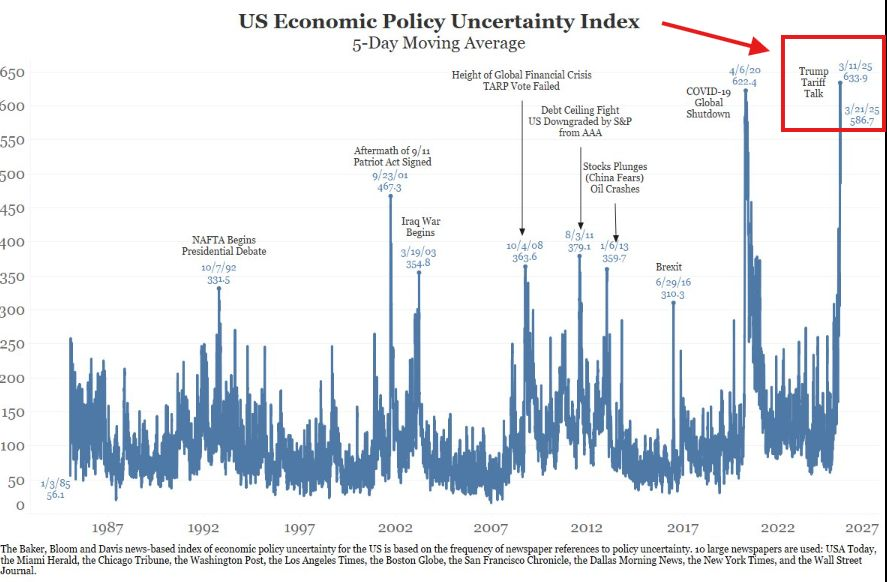
The analyst stated that trillions of dollars have been pulled from the stock market. However, he expressed optimism that much of this capital will find its way into Bitcoin, presenting a potential opportunity for the cryptocurrency.
Meanwhile, another analyst addressed concerns about a potential repeat of the 2008 financial crisis. He noted that such an event is highly unlikely in the current market. Instead, he forecasted a recovery akin to the rapid rebound following the 2020 crash.
“Current market crash is looking a lot like March 2020. Back then, it was a generational entry point for crypto, and the few who stayed patient walked away with millions,” he wrote.
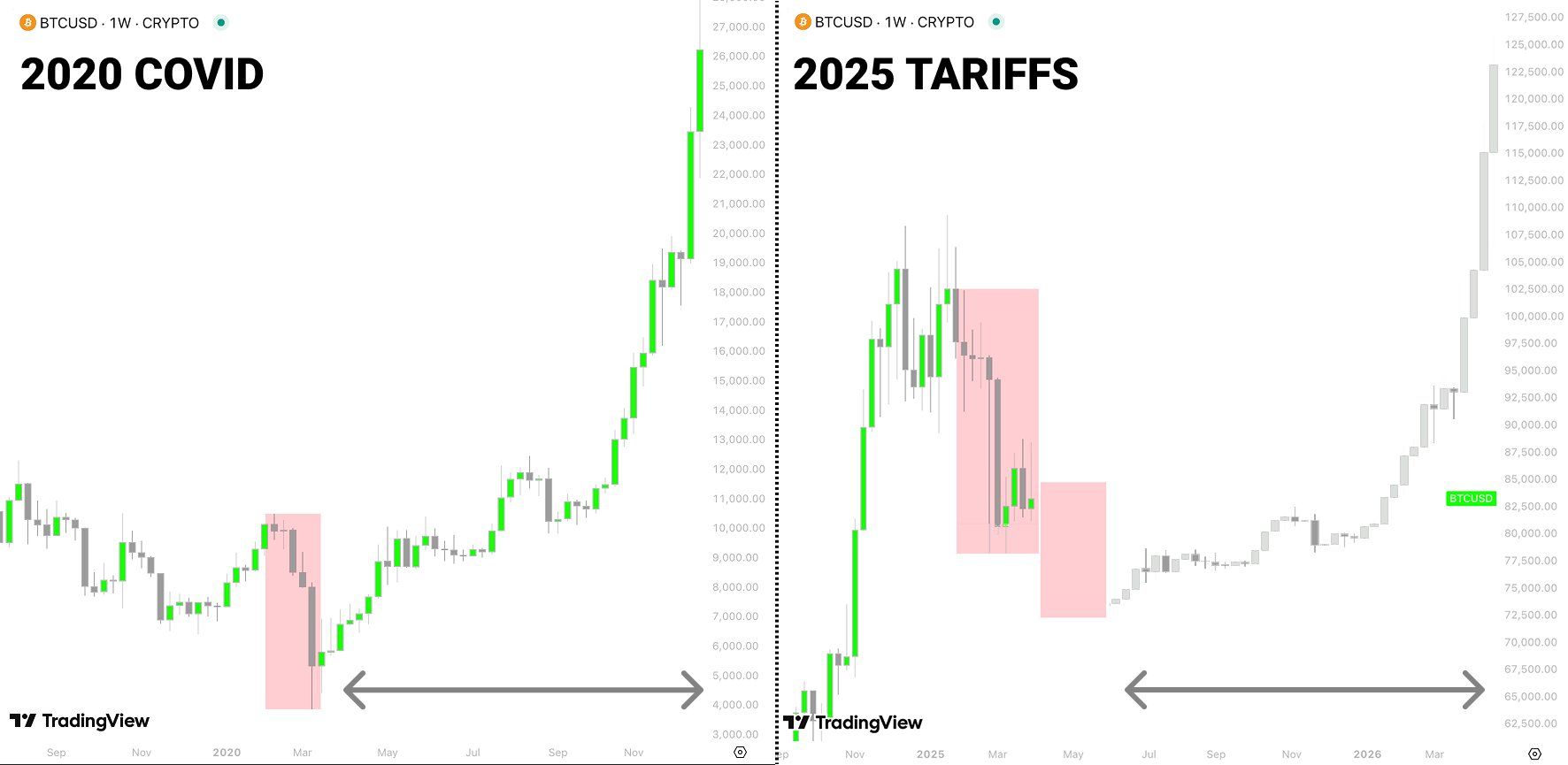
Drawing parallels to the 2020 market downturn, he pointed out that the current market is likely halfway through its correction phase. The analyst also emphasized that after the 2020 crash, central banks responded by slashing interest rates and injecting massive liquidity into the economy.
This surge in liquidity played a crucial role in pushing stocks and risk assets to new record highs in the subsequent year.
“If we’re mirroring the 2020 price action, which I believe is likely, you’ll encounter generational opportunities in crypto. Be patient and start paying close attention, next weeks and months will be decisive. Buy fear, but don’t rush into it, chances are it’s still early,” the analyst explained.
Nonetheless, he stressed that several uncertainties remain, including the duration and impact of tariffs, other countries’ responses, and whether Bitcoin can decouple from the S&P 500 as a recession hedge.
This perspective aligns with another expert, who suggested that the present turmoil could pave the way for a new generation of crypto millionaires to emerge.
“Remember the COVID crash in 2020. BTC was $3,850, ETH was $100, XRP was at $0.11. And all these projects went on to create millionaires over the next few years!” he claimed.
As markets grapple with unprecedented uncertainty, the coming months will likely determine whether this period marks a turning point for a new wave of wealth creation or a deeper economic downturn.
Disclaimer
In adherence to the Trust Project guidelines, BeInCrypto is committed to unbiased, transparent reporting. This news article aims to provide accurate, timely information. However, readers are advised to verify facts independently and consult with a professional before making any decisions based on this content. Please note that our Terms and Conditions, Privacy Policy, and Disclaimers have been updated.
Bitcoin
$1 Billion in Liquidations Over the Weekend

Industry players have labeled today, April 7, the crypto black Monday, a sentiment drawing from the bloodbath over the weekend.
Over the past two days, over $1 billion in long and short positions were wiped out by the weekend volatility.
Crypto Black Monday After Weekend Bloodbath
Data on Coinglass shows up to $116.59 million worth of positions were liquidated on Saturday, April 5. This comprised $33.02 million and $83.57 million in short and long positions, respectively.
The next day, the volume of traders and investors blown out of the water increased as crypto liquidations came in over $850 million. Like the day before, the lion’s share of these liquidations was long, at $743.115 million, against $107.881 million short positions.
“In the past 24 hours, 320,444 traders were liquidated, the total liquidations come in at $985.82 million,” Coinglass noted.

This volume of liquidations has fueled widespread pessimism across the crypto market. Data on CoinGecko shows the total crypto market cap is down by over 10% to $2.5 trillion.
Among the crypto top 10, XRP price is leading the crash, down by over 15.4% to trade for $1.7 as of this writing. Likewise, Ethereum’s price was down by 14.3%, selling for $1,480 at press time.
Analysts on X (Twitter) are buzzing about the potential for a historic crash reminiscent of “Black Monday.”
“Tomorrow [meaning April 7] is shaping up to be Black Monday 2.0,” analyst Maine remarked.
“Black Monday” refers to a significant and sudden stock market crash on October 19, 1987. That day, major stock indices worldwide plummeted, with the Dow Jones Industrial Average (DJIA) in the United States dropping by 22.6%. This marked its largest single-day percentage decline in history.
Against this backdrop, panic ensued as trading volumes overwhelmed markets. The lack of mechanisms to pause trading during extreme volatility allowed the free-fall to continue unchecked.
Following the massive liquidations, data on Google Trends shows global “black Monday” searches at peak levels.
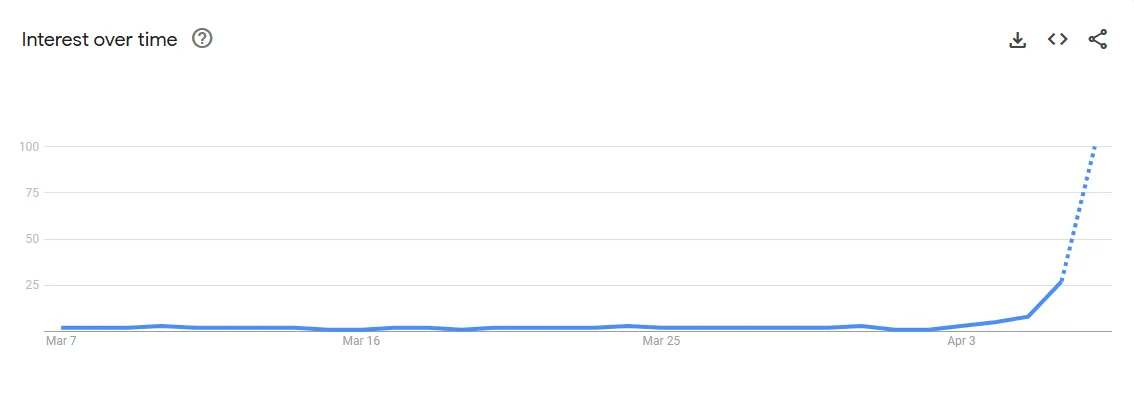
“Bearish sentiment is arguably near its highest levels in history,” The Kobeissi Letter remarked.
Panic Week: What’s Behind Crypto Black Monday?
The renowned market commentary attributed the gloom to uncertainty surrounding proposed tariffs, describing “Black Monday” as the consensus view. Based on this, analysts at The Kobeissi Letter predict “short-term capitulation” this week.
“Down then up,” analysts wrote, hinting at a volatile but potentially rebounding market.
This sentiment aligns with the AAII Sentiment Survey, which reported a striking 61.9% bearish outlook. Notably, this is double its historical average of 31.0%.
“Black Monday 2.0,” TheMaineWonk warned.
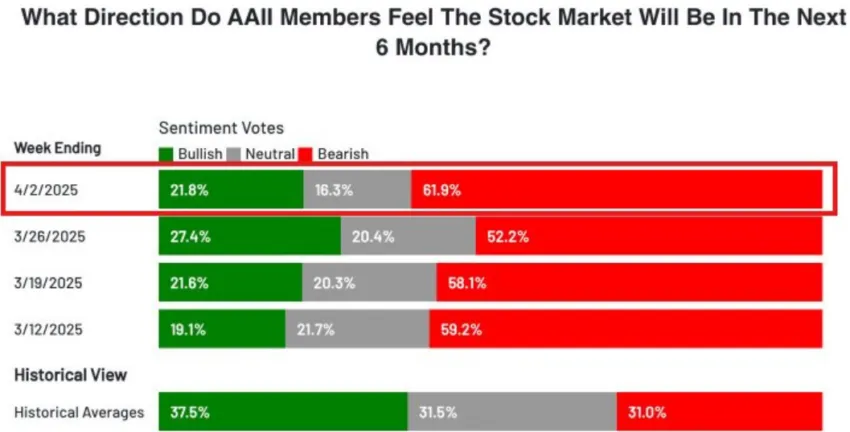
Analyst Duo Nine supports this supposition. He warns that Trump tariffs could dismantle global supply chains, reduce productivity, and lead to a prolonged bear market for crypto. However, he believes this could last 1-2 years if a recession hits.
“If the US does not make a U-turn soon, then the only conclusion is that this is intentional and the damage will only increase with time. Unfortunately, for crypto, this means the start of a prolonged bear market. It can last 1-2 years or more if a global recession starts,” Duo None explained.
While tariff fears dominate, contrarian investors might view the extreme pessimism as a buying signal. This perception is based on the assumption that when such dire predictions become mainstream, the market bottom may be near. Such a move would offer opportunities amid peak fear.
Not everyone agrees with the apocalyptic tone. Ryan Wollner, founder of Pearpop, urged caution against overblown narratives on X. He also dismissed comparisons to the 1987 crash.
“I think we might only be looking at a 2-3 week transition, and then we will see people buying back in once the tariffs are more understood, “Wollner said.
Wollner suggested savvy traders could profit by selling now and buying low soon. He emphasized that unlike past recessions driven by fraud, this downturn reflects a temporary shift, with funds likely flowing to US companies and tariff-favored nations.
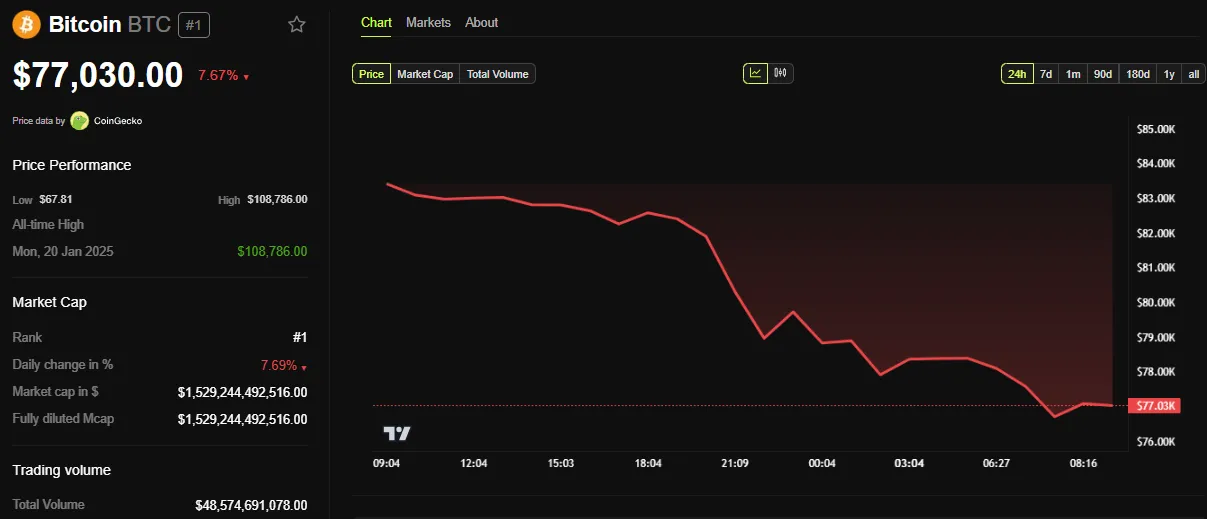
BeInCrypto data shows Bitcoin is down by nearly 8% in the last 24 hours to trade for $77,030 as of publication time.
As markets brace for turbulence, opinions remain between impending doom and opportunistic rebounds.
Disclaimer
In adherence to the Trust Project guidelines, BeInCrypto is committed to unbiased, transparent reporting. This news article aims to provide accurate, timely information. However, readers are advised to verify facts independently and consult with a professional before making any decisions based on this content. Please note that our Terms and Conditions, Privacy Policy, and Disclaimers have been updated.
-

 Altcoin18 hours ago
Altcoin18 hours agoExpert Reveals Decentralized Strategy To Stabilize Pi Network Price
-

 Market24 hours ago
Market24 hours agoConor McGregor’s Crypto Token REAL Tanks After Launch
-

 Bitcoin20 hours ago
Bitcoin20 hours agoUS Macro Setup To Favour New Bitcoin ATH In The Long Run
-

 Market20 hours ago
Market20 hours ago3 Token Unlocks for This Week: AXS, JTO, XAV
-

 Ethereum19 hours ago
Ethereum19 hours agoEthereum Lags Behind Bitcoin In Q1 Performance Amid Market Downturn – Details
-

 Market17 hours ago
Market17 hours agoBitcoin Price Drops Below $80,000 Amid Heavy Weekend Selloff
-

 Market23 hours ago
Market23 hours agoCelestia (TIA) Price’s 30% Crash Prolonging Could Bring Recovery
-

 Market22 hours ago
Market22 hours agoRipple Highlights UK’s Potential to Become Global Crypto Hub


















